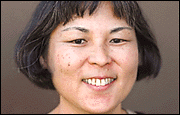

![]()
View Point


![]()
View Point
WHILE I share Professor Michael Bevis' concerns about the deteriorating research infrastructure of the University of Hawaii at Manoa campus (View Point, Sept. 3), his conception of and recommendations regarding the UH-West Oahu campus are misinformed. West Oahu campus
is vital to UHProfessor Bevis contends that development of the UH-WO campus at Kapolei is merely intended "to save some UH students the drive from one side of Oahu to the other."
That statement reveals a lack of information about UH-WO's mission and activities, and about the very real limitations of the Manoa campus.
Moreover, it results in scapegoating UH-WO, an approach that is not at all constructive in these tough budgetary times.
For nearly a quarter century, UH-WO has provided a quality alternative to the kind of access and baccalaureate educational experience provided by UH-Manoa, both on Oahu and on our neighbor islands.
From 1981, long before administrators began extolling the potential of "distance education," UH-WO has provided face-to-face access to baccalaureate degrees in professional studies (business administration and public administration) to students on Kauai and, from 1983, to those on Maui.
This year, West Hawaii, Molokai and Lanai students are also being served via the Hawaii Interactive Television System.
About half of the courses scheduled each term at UH-WO are offered in the evenings or on weekends. This permits students with day-time jobs to obtain their bachelor of arts degrees after having completed their associate of arts degrees at community colleges.
These courses are predominantly taught by our full-time faculty, whereas at UH-Manoa predominantly by adjunct faculty. Many of the students in these classes are those who had not been adequately served at Manoa. While they may have been able to take some classes, they could not complete an entire and coherent program of study, nor could they receive the kind of mentoring they have found at UH-WO.
UH-WO provides a challenging but supportive learning environment to our diverse student population. The Waianae coast may be only 30 miles from UH-Manoa by car, but it is also a cultural gulf away for students who are kanaka maoli, Filipino, working class, women, gay/lesbian/bi-sexual, and active duty and families of military personnel.
Although our faculty are actively engaged in research and are well published, our priority is on excellent teaching and mentoring. Our faculty and staff provide a rigorous but supportive learning environment which permits our students to thrive and achieve their educational goals.
UH-WO's 98 percent graduate satisfaction rate (highest in the UH system), and the success of our students in graduate and professional programs and in the larger community attest to our campus doing its part to develop the human capital of our labor force. We are helping to reverse the growing educational gap between the rich and poor, and to facilitate democratic participation in our communities.
Lastly, Leeward and Central Oahu are the fastest-growing regions in Hawaii, far surpassing the growth on Maui, Kauai and the Big Island.
The UH-WO campus is not only being built for today, but also for the 21st century. It has to be built because the UH-Manoa campus alone cannot possibly serve the growing number and diverse types of students needing and demanding quality higher education.
We need to appreciate the different and complementary missions of each of our campuses and build the best UH system we can.
Joyce N. Chinen is an associate professor of sociology and
chairwoman of the UH-West Oahu faculty senate.